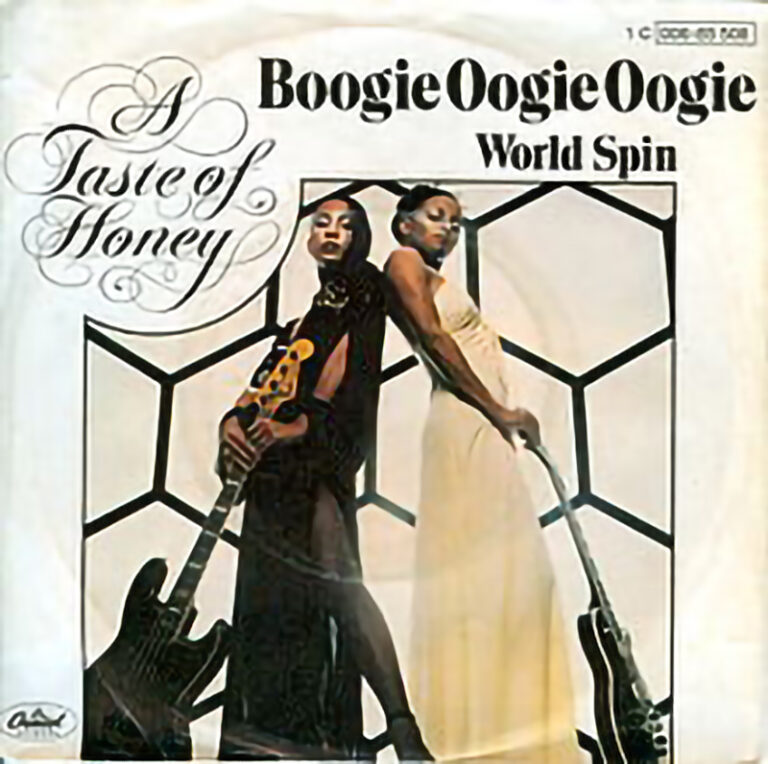6

Boogie Oogie Oogie - A Taste of Honey

B-Side: World Spin
From the Album: A Taste of Honey
Released: June 16, 1978
Recorded: 1978
Studio: Pasadena Sounds (Los Angeles, California)
Genre: Disco, funk
Length: 5:37
Label: Capitol (Capitol 4565)
Songwriter(s): Janice-Marie Johnson, Perry Kibble
Producer(s): Fonce Mizell, Larry Mizell
The nucleus for A Taste of Honey was formed in 1971, through the friendship of Perry Kibble and Janice Johnson. At the time, Perry was working as a bassist with a soul trio, the Exits, while Janice was singing in a group called Soundstage #1. When those two acts fell apart, Perry and Janice decided to join forces.
The two added a couple of friends and landed a job at a nearby beer joint, L.C.’s Hideaway, for $50 a night. They went through several drummers before finding Donald Johnson (no relation to Janice), who was hired and appeared with the group during their three-month run at the club.
By the summer of 1972, they had adopted their unusual name, taken from the 1965 hit by Herb Alpert and the Tijuana Brass. They had also added another singer and conga player, and had become a six-piece band. They signed their first management contract and were immediately shipped overseas on a six-week USO tour. Over the next four years, they alternated between stateside dates and tours of other countries. Among dozens of stops were spots in Spain, Morocco, Taiwan, Japan, Thailand, and the Philippines. Along the way, various performers joined and left the act, but the three key members — Perry, Janice and Donald — always remained.
In early 1976, the group’s lead singer, Gregory Walker, suddenly quit and joined a rival band, Santana. The others decided they’d had enough of floating personnel and elected to form a permanent four-piece line-up. By that time, Janice was not only singing but also playing lead guitar. To complement her, they hired a second female lead guitarist, Hazel Payne. After five years of experiments, A Taste of Honey had finally come together and was ready for the big time.
A friend, Dr. Otto Stallworth, saw them perform at a backyard wedding in Los Angeles and arranged for the group to meet Larry and Fonce Mizell, producers of hits for the Jackson Five, L.T.D., and other acts. Larry and Fonce liked what they heard and were particularly fascinated by the novelty of two female lead guitarists. They arranged for the band to meet Larkin Arnold, then a vice president of Capitol Records. Arnold auditioned the group in early 1978, but then hesitated. Three months later, they were asked to do a repeat audition. Finally, Capitol signed them, and work began on their debut release, “Boogie Oogie Oogie.”
“It’s funny how that song came about,” said Janice, who co-wrote the tune. “We played a lot of military bases around the world, and one night we were playing at this certain Air Force club. We were knocking ourselves out but getting no reaction from the crowd. In fact, they seemed to have contempt for two women who thought they could front a band, get out and strut their stuff and all. Well, it didn’t take me long to come up with a good lyric. When we got home, I picked up my bass, and with our keyboard man, Perry Kibble, we worked out a melody. Next time you hear ‘Boogie Oogie Oogie,’ listen to the words!
“We picked the song to be our first single right away. But it didn’t break in L.A., our hometown. It took off in New York and shot through the Midwest, and didn’t get to L.A. until many weeks later. This is a crazy market. It broke out of the discos first, and then radio picked it up.”
“Boogie Oogie Oogie” became a number one across-the-board hit and the first platinum single in Capitol Records’ history. The group’s debut album, A Taste of Honey, sold nearly two million copies, and they became the first black group to win the Grammy for Best New Artist of the Year. They were also the only group ever to have both their debut single and debut album certified platinum and to win the coveted Best New Artist award all in the same year.
,p>”Boogie Oogie Oogie” has been called everything from disco at its worst to one of the best R&B singles of the decade. It was, at least, a fascinating souvenir of the time — a record that encapsulated all the carefree abandon that made disco so popular.





